Sexual Maturity
Like most seabirds, penguins tend to be long-lived. They may take three to eight years to reach sexual maturity.
With some of the smaller species, convenance may begin at three to iv years, only most larger species are not accomplished breeders until much afterwards. On boilerplate, breeding does not begin until the 5th year, and a few males do not brood until the eighth year.
Mating Activity
Breeding seasons differ from species to species.
- Most species have an annual breeding season - leap through summertime.
- The king penguin has the longest breeding cycle of all the penguin species, lasting 14 to 16 months. A female person king penguin may produce a chick during alternate breeding seasons.
- Emperor penguins breed annually during the antarctic winter, June through August.
- During the emperor breeding season, air temperature may drop to -threescore°C (-76°F) and winds may reach speeds upwardly to 200 kph (124 mph.)
- For virtually of the winter, antarctic penguins alive in an environment of darkness or half-low-cal. Why emperors breed during the harshest season of the year is unknown, just some scientists speculate that when the chicks get contained five months later (in January and February, the antarctic summer), environmental conditions are more than favorable for the young birds.
- The trivial penguin breeds throughout the year and has the shortest breeding cycle, which lasts most 50 days.
- Some of the temperate penguins, like the Humboldt and the African, tend to nest throughout the year.
Courting.
Courting varies among species. Information technology generally begins with both visual and auditory displays. In many species, males display starting time to establish a nest site and then to attract a mate. Not all species exhibit all displays, but in general there are 3 distinct types of displays.
- Ecstatic. Also called trumpeting, caput swinging or advertisement, this display establishes possession of a nest site, attracts females and warns other males to stay away. Males at the nest site usually exhibit the ecstatic display before females arrive or when building nests. The male may dip its caput low and so stretch its head
and neck upward with flippers held outstretched and squawk or "bray". Male penguins can perform the ecstatic display in a sitting or standing position. Some species, like the Adélie, chinstrap and crested penguins, may swing their caput or flap their flippers while calling. - Mutual ecstatic. Once paired, male and female penguins perform the common ecstatic display together. This display seems to strengthen the pair bond, coordinate nesting behavior, and advertise a nesting territory. The mutual display is similar to the ecstatic display—caput and cervix stretched upward with a braying song.
- Crested, castor-tailed, and temperate penguins, stand up facing each other, performing the activity in unison. Inside these species at that place are some beliefs differences. For example, gentoos generally agree their outstretched head and flippers still, while macaronis flap flippers and scroll their heads from side to side.
- Emperor penguins have a unique mutual display position: Standing face up-to-face, individuals concur their heads downward with bills pointed to the ground while braying. Mutual displays continue throughout the convenance flavor, oft taking identify at the nest when parents switch places for egg incubation and chick feeding.
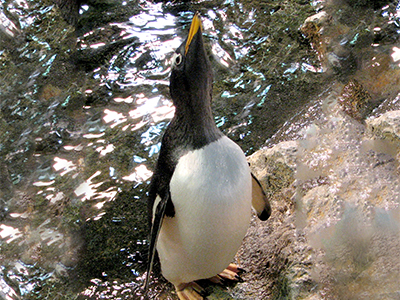
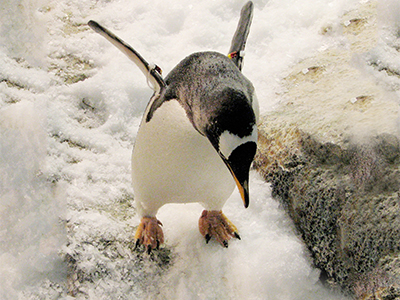
- Bowing. Bowing displays may lessen the likelihood of aggression and strengthen recognition betwixt partners. One or both of the penguins dips its caput and points its nib at the nest or at the other bird's pecker. The call is a low hiss or growl.
- Crested penguins may vibrate their bills while pointing in a type of display called "quivering."
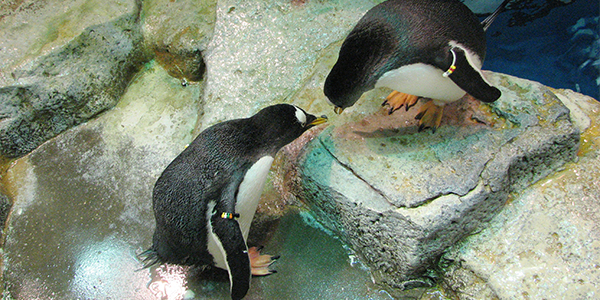
- Emperor and male monarch penguins are the only known marine birds to reflect ultraviolet (UV) light from their bills, and a male male monarch penguin'southward neb may exist used every bit a cue in finding and selecting a mate.
- UV light, invisible to the human heart, can be perceived past most birds. UV reflection off the feathers of studied songbirds has been a recognized cistron for mate selection.
- During courtship, king penguin males come confront-to-face up and flaunt their bills to possible mates. The stiff contrast of the blackness background of their bills is believed to broaden UV light reflection.
- The bills of sexually immature rex juveniles do non reverberate UV light, adding to the hypothesis that UV reflection in adult males is used to concenter mates.
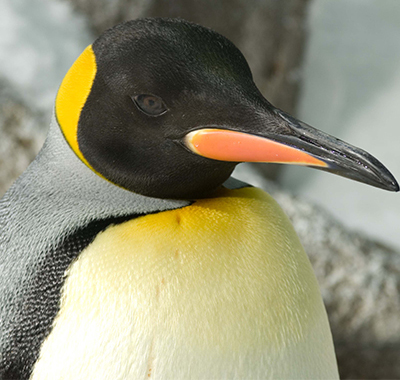
The strong contrasting black background of this king penguin'due south bill is believed to augment UV light reflection.
Most penguin species are monogamous (one male person breeds with one female during a mating flavor); however, research has shown that some females may have one to three partners in 1 season and some males may take 1 or two partners.
Mate selection is up to the female, and it is the females that compete for the males.
In some penguin species, a female person selects the same male from the preceding season to mate with. Adélie penguins have been documented re-pairing with the previous yr'southward mate 62% of the fourth dimension. Chinstraps re-paired in 82% of possible cases, and gentoos re-paired 90% of the time. In one study of Adélies, females paired with males inside minutes of arriving at the colony.
When a female person selects a different mate it is usually because her mate from the previous flavor fails to return to the nesting area. Another reason may be mistiming in returning to the nesting area. If they arrive at dissimilar times and miss each other, one or both penguins may obtain new mates.
Eudyptes penguins are closely related and some in this genus are known to crossbreed with unlike Eudyptes members. Rockhoppers are known to interbreed with macaroni, royal, and cock-crested penguins, for instance, with matings producing hybrid offspring that in some cases have successfully reproduced as well.
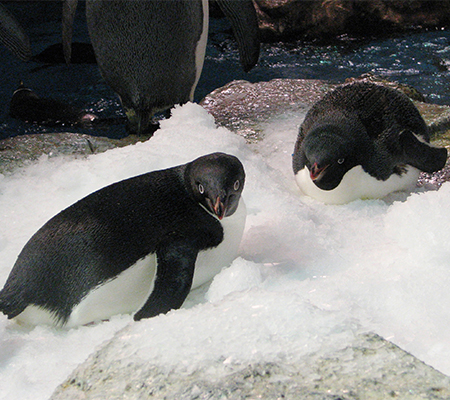
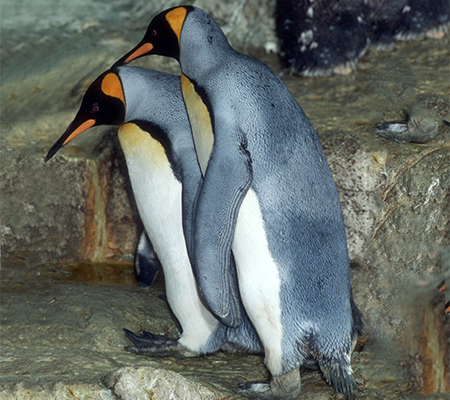
Nesting
Nest site fidelity.
- Studies take shown that nigh penguin species tend to be faithful to the aforementioned rookeries and return each year. Most penguins return to the same territory within the rookery. Male Adélie penguins were 99% true-blue to the previous year's territory, chinstraps were 94% faithful and gentoos 63% faithful.
- Rockhoppers appear to have an amazingly precise breeding timetable, with males returning to the spot of their quondam nest virtually on the same day each year, Regardless if weather or environmental factors have inverse from the previous convenance season.
- Males get in first to the rookeries to constitute and defend their nesting sites.
- In a study on Adélie and chinstrap penguins, females arrived i day and five days after the males, respectively.
- When it is time to brood, mature birds return to the rookery where they hatched. This results in big numbers of penguins at a unmarried rookery rather than penguins colonizing new areas. Some penguin rookeries number millions of birds.
- When it is time to breed, mature birds return to the rookery where they hatched. This results in big numbers of penguins at a single rookery rather than penguins colonizing new areas. Some penguin rookeries number millions of birds.
- Various penguin species may share a particular rookery site. Information technology is not uncommon to find gentoos nesting near Adélie and chinstrap penguins for example, simply nesting areas within the rookery are kept segregated by each species.

Cape Adare is home to the largest single colony of Adélie penguins with an estimated population of 282,000 convenance pairs.
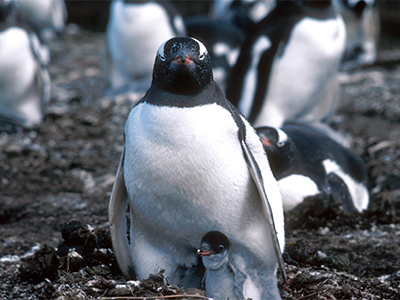
Gentoo penguins nest inland or on coastal peninsulas and islands.
Nesting habitats vary amid species.
- Emperor penguins form colonies around the shoreline of the antarctic continent and next islands. They adopt sites on a fairly level surface of water ice in areas sheltered from wind, with piece of cake admission to feeding areas.
- Rex penguins nest and breed on subantarctic and antarctic islands. They prefer beaches and valleys of level ground or gentle slopes, complimentary of snow and ice and accessible to the ocean.
- Adélies oftentimes nest 50 to 60 km (31.1 to 37.3 mi.) from the border of the ocean ice on the antarctic continent and nearby on rocky islands, peninsulas, beaches, hillsides, valleys, and other areas complimentary of ice.
- Gentoo penguin colonies tin be inland or coastal on antarctic and subantarctic islands and peninsulas. They tend to brood on ice-gratis ground on beaches, in valleys, on inland hills and on cliff tops.
- Chinstrap penguins nest on fairly steep slopes.
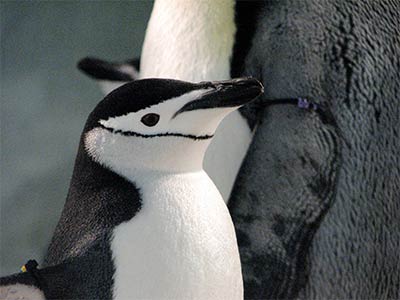
The S Sandwich Islands have the largest population of nesting chinstraps with an estimated v 1000000 pairs.
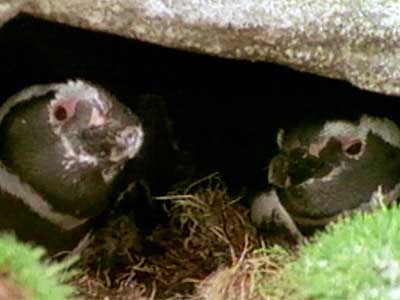
Temperate penguins nest in secret burrows.
- Fiordland crested penguins nest in a wet, coastal pelting forest habitat, under bushes, betwixt tree roots and in holes.
- Galápagos penguins nest in volcanic caves or cracks in rock.
- The temperate penguins and the little penguin often nest underground in burrows, stone crevices, caves, under shrubs or in scrapes in the ground. These species brood in areas where the climate can range from tropical to subantarctic. Underground or other sheltered burrows provide an environment with a relatively constant air temperature for the eggs and chicks.
- Some Humboldt penguins burrow and create nesting sites in guano (fecal) deposits.
Nesting materials vary from species to species and from location to location.
- Adelies build nests of small stones that they use to line depressions in the ground. Some chinstrap and gentoos also construct nests out of stones. The stones help go along the eggs above the surface when the rookery floods from melting snow. Adélie, gentoo, and chinstrap penguins are known to take stones from other nests. A penguin returning to the nest sometimes brings its mate a stone every bit a courtship gesture.
- Chinstrap penguins usually construct nests with perimeters of viii to 10 stones, simply enough to prevent eggs from rolling away.
- Gentoo penguins use nesting materials ranging from pebbles and molted feathers in Antarctica to vegetation on subantarctic islands. Ane medium-sized gentoo nest was equanimous of 1,700 pebbles and 70 molted tail feathers.
- Emperor and king penguins build no nests. They stand upright while incubating a single egg on the tops of their feet under a loose fold of abdominal. Nether this loose fold is a featherless patch of skin called a breed patch, which occurs in all incubating birds. The brood patch contains numerous blood vessels that, when engorged with claret, transfer body heat to the eggs.
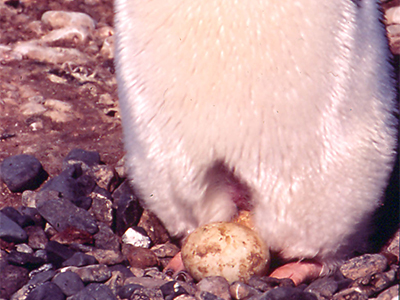
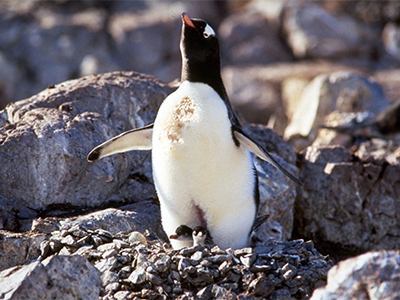
Eggs
Eggs may be white to bluish or green. The shape varies amidst species. In Humboldt and Adélie penguins the egg is more or less circular. In emperor and male monarch penguins the egg is rather pear-shaped, with one finish tapering most to a point. With this elliptical shape, if an egg falls off of the feet of a parent bird, the egg will roll in a circle instead of away from the parent.
Egg size and weight varies with species. From the records of SeaWorld'southward successful penguin breeding programs, emperor penguin eggs measure 11.1 to 12.7 cm (four.4 to 5 in.) long and weigh 345 to 515 thou (12.1 to 18 oz.), and Adélie penguin eggs measure 5.5 to 8.6 cm (2.two to three.4 in.) long and weigh 61 to 153.five grand (2.ane to 5.4 oz.).
A nest of eggs is called a clutch, and with the exception of emperor and king penguins, clutches usually contain ii eggs. (Emperor and king penguins lay a single egg.) A clutch with more than i egg presents a better chance of at to the lowest degree one chick surviving.
- In the Eudyptula, Spheniscus, and Pygoscelis genera, the start-laid egg is generally larger than the 2d, and usually hatches first (except in the chinstrap species.) Commonly the first chick to hatch has the survival reward since information technology volition already accept fed and will be larger by the fourth dimension the 2nd egg hatches. The second, usually smaller, chick cannot compete with the larger chick for food and may perish in times of scarce food resource.
- In the Eudyptes genus, the second-laid egg and the subsequent chick is usually the larger of the two and usually the survivor. It typically hatches first or at the same fourth dimension equally the chick from the offset-laid egg. The first-laid egg is often kicked out of the nest by the adults prior to hatching time.
- The chinstrap and yellow-eyed species usually lay ii eggs. Parents typically enhance both chicks, which are nearly equal in size.
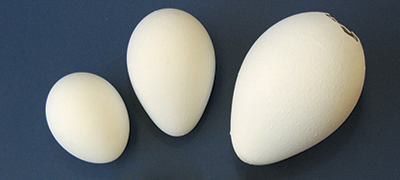
Penguin eggs from left to right: gentoo, king, and emperor.
Incubation
Incubation is the time spent warming the egg before information technology hatches. With the exception of emperor penguins, partners have turns incubating eggs, allowing each mate to go out to feed for several days at a time.
A female emperor penguin transfers a single egg to the top of her mate'due south feet. The female goes to sea to feed while the male incubates the egg. She returns several weeks later, ordinarily just before the egg is prepare to hatch, to relieve her mate so that he may feed. The male person fasts throughout the courtship, nesting, and incubation periods. He lives off reserves of torso fatty which may be 3 to 4 cm (1.2-1.six in.) thick, and loses upward to 45% of his body weight.
The incubation menstruum varies with species. It may be every bit short as one month, equally in the erect-crested penguins, or as long as 62 to 66 days for emperor penguins.
The incubation temperature for penguins is approximately 36°C (96.5°F); it is a bit lower for the larger species. Emperor penguins tin maintain an incubation temperature of 31°C (87.8°F) in an surroundings that is -60°C (-76°F.)
The greatest single crusade for reproductive failure in some species is the mistiming betwixt parents for nest relief during incubation. This commonly occurs when the female fails to render from a foraging trip earlier the male deserts the nest. A male will spontaneously go out the nest and eggs when the motivation to feed overcomes that for incubating eggs.
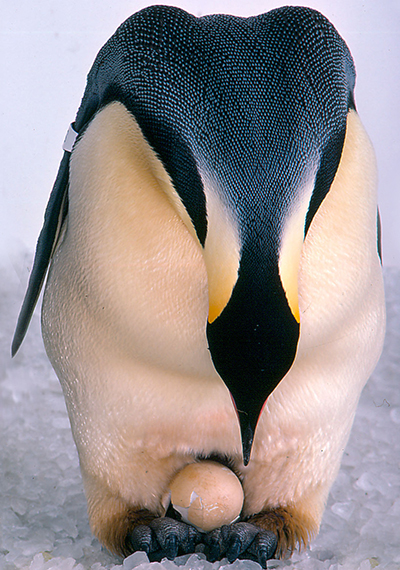
0 Response to "Are Male Penguins Only Animal To Sit On The Egg"
Post a Comment